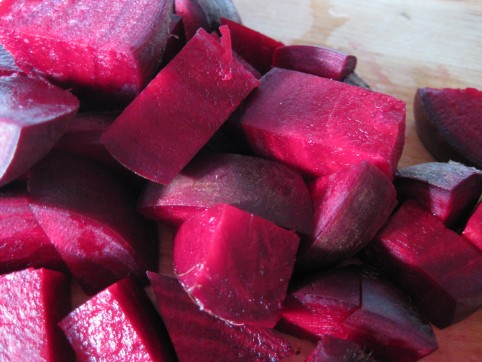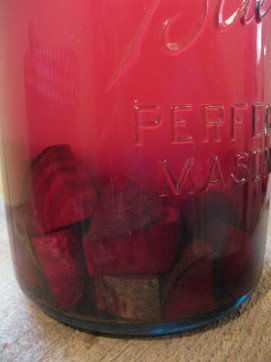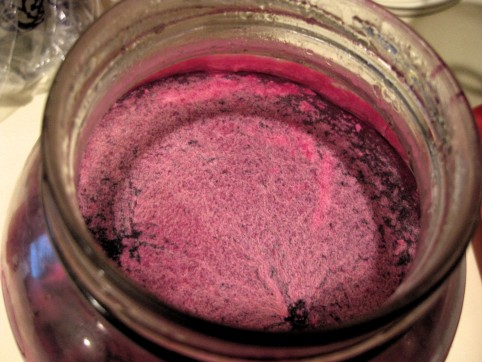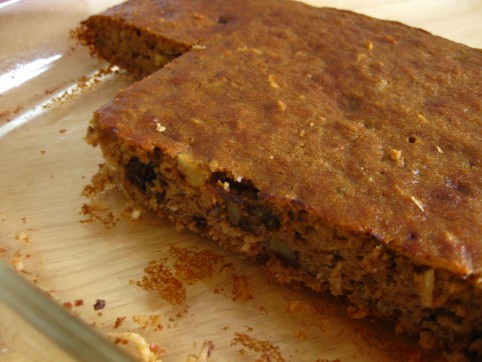
Sauerruben is made just like sauerkraut, only with rutabagas (or turnips, or a combo). It’s lovely stuff, and a nice change from kraut. It has a sweet, radish-like bite — although that will mellow out after a few weeks in the fridge. I like sauerruben a lot more than I thought I would, especially after it mellowed. Give it a try!
Ingredients:
Rutabagas (or turnips, or a combo), washed/scrubbed. I don’t bother to peel mine.
Sea salt (see my salting chart below, plus you may need more to mix up extra brine. (Any non-iodized salt will do, but unrefined sea salt is better for your body.)
*****
Here’s my salting chart. I usually just stick to this, but you can add a little more salt in the summer and a little less in the winter if you like.
10 tsp salt per 5 lbs vegetables
5 tsp salt per 2 ½ lbs vegetables
2 tsp salt per 1 lb vegetables
1 tsp salt per ½ lb vegetables
½ tsp salt per ¼ lb vegetables
*****


Shred, grate, or finely chop your rutabagas. Add the salt, and mix well.
I let this sit on the counter for several hours or overnight (this step is in place of pounding) so that the salt can begin to draw water out of the rutabagas. The water contains nutrients, and these nutrients then become the substrate for the growth of the lactic acid bacteria which is what turns your rutabagas into sauerruben. (Steinkraus, Handbook of Indigenous Fermented Foods, p.120.)
After some water has been drawn out, pack the rutabaga WITH its water into a glass jar. You really want to pack it in there (use your fist or any kitchen tool), because this will help squeeze more water out. You can also use a specially-made ceramic sauerkraut crock, or a glass or ceramic bowl (anything except metal, since salt and acid can react with metal).
Keep the rutabaga submerged under the brine by placing a smaller plate on top and weighing it down with something heavy (a jug of water, a boiled rock, etc.). Or, nest a smaller jar of water inside your larger glass jar.
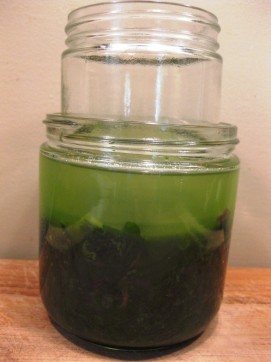
This is kale, not sauerruben, but same idea. I particularly like this nesting-jars method for keeping everthing submerged under the brine.
Whatever method you devise, just be sure that all traces of rutabaga are completely submerged in the brine. Little bits sticking up above the water line will quickly lead to a moldy situation (and if you do end up with mold, scrape off the entire top layer, but the rest underneath should be fine!). So if you need to mix up some more brine (which is just a fancy name for salt water), use the ratio of 1 tsp salt to 1 cup of water.
Cover the jar with a towel to keep bugs out. Leave it to ferment at room temperature until you like the taste of your sauerruben. Let your tongue be your guide to done-ness. Taste it every few days, and transfer into the fridge when it tastes the way you like it. I like mine pretty sour, so I usually leave it out for 1-2 weeks or more, depending on how warm it is in the kitchen. If the taste is right but the ‘ruben is still too bitey, shove it to the back of the fridge for several weeks for it to mellow out.

Once in the fridge, your sauerruben will keep for many months. And when it’s all gone, don’t throw out the juice; it’s full of beneficial Lactobacillus (lactic acid bacteria) and is said to be a very good digestive tonic. And if you like, add a little of the juice to your next batch of sauerruben as a starter.
Troubleshooting:
If you see a white film (“kahm yeast”) develop on the surface of the brine, scrape off what you can each day until the ‘ruben is done fermenting. Sometimes I don’t get any film. Sometimes I get a fair amount. There doesn’t seem to be any rhyme or reason. The kahm yeast won’t harm anything, but if you keep getting a lot of it day after day, it can sometimes (not always) impart an off taste to the brine. Just try to scrape it off on a regular basis (daily is nice).
*****






